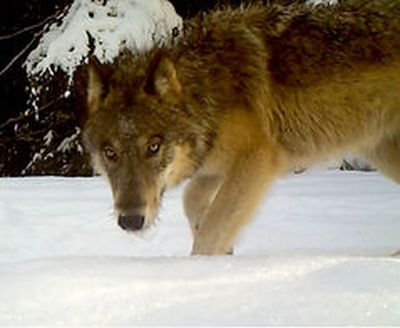WDFW authorizes lethal removal of Ferry County wolves for second time in a year

The Washington Department of Fish and Wildlife authorized the lethal removal of wolves in Ferry County’s Kettle River mountain range on Friday.
Friday’s order is the second within a year authorizing the killing of wolves from the Togo pack after confirmed depredations on cattle in the area. Last August, WDFW Director Kelly Suseman authorized lethal removal of Togo wolves following three confirmed depredations within 30 days. No wolves were successfully killed as part of that effort.
Last week, WDFW announced it had confirmed the seventh Togo pack depredation within 10 months . The calf survived its injuries, confirmed to be wolf-caused by WDFW staff.
The department’s lethal removal policy allows killing wolves if they have attacked or killed livestock three times within the last 30 days or four times within 10 months. Two nonlethal deterrents must be deployed before kills can occur.
According to a WDFW statement, the livestock owner had several nonlethal deterrents in place, including human presence around calving areas and delayed turnout of calves to coincide with the availability of deer fawns and elk and moose calves for prey.
“WDFW staff believe depredations are likely to continue in the near future even with the non-lethal tools being utilized, and that there are no reasonable, additional reactive non-lethal tools that could be deployed,” the department statement reads.
Several wolf packs are confirmed to exist in the Kettle River Range, which WDFW spokesperson Staci Lehman described as “perfect wolf habitat” due to the remote terrain and herds of livestock throughout the area.
Lehman said the department has been unable to place radio collars on any Togo pack members, making absolute confirmation of the pack’s involvement difficult. However, range riders have seen the same few wolves, identified as Togo pack members, among the cattle many times, Lehman said, and WDFW trail cameras in the area seem to confirm those sightings.
The order authorizes the removal of up to two pack members. Livestock owners will be granted permits to kill wolves as part of the effort along with WDFW staff, Lehman said. Last year’s effort did not include livestock owners, and Lehman said the hope was that their participation would ensure removals this time.
The most recent available numbers suggest the Togo pack currently has four members. Lehman said lethal removal of up to half the pack won’t hurt overall recovery efforts among wolf populations, which have been classified as endangered throughout Washington since 1980.
WDFW reported in April that wolf populations had grown by up to 11 percent in 2019, despite ongoing lethal removals and natural deaths.
“Removing two members might hurt this particular pack, but it won’t affect recovery goals through the state overall,” Lehman said.
No killings will take place until Tuesday, according to the WDFW statement. The waiting period ensures any concerned parties have time to begin legal action to stop the removals, Lehman said.
Suseman previously authorized incremental removal of the Togo pack in August 2018, during which one wolf was killed by WDFW staff. Removal of the pack’s remaining three wolves was authorized in November 2018 following repeated depredations, but none were killed.